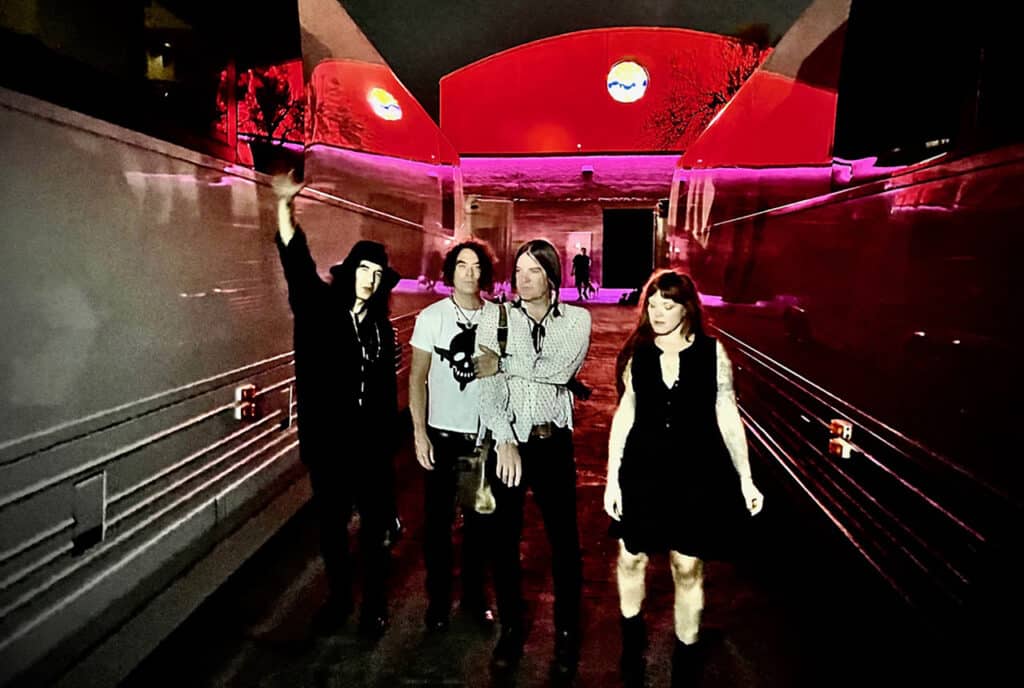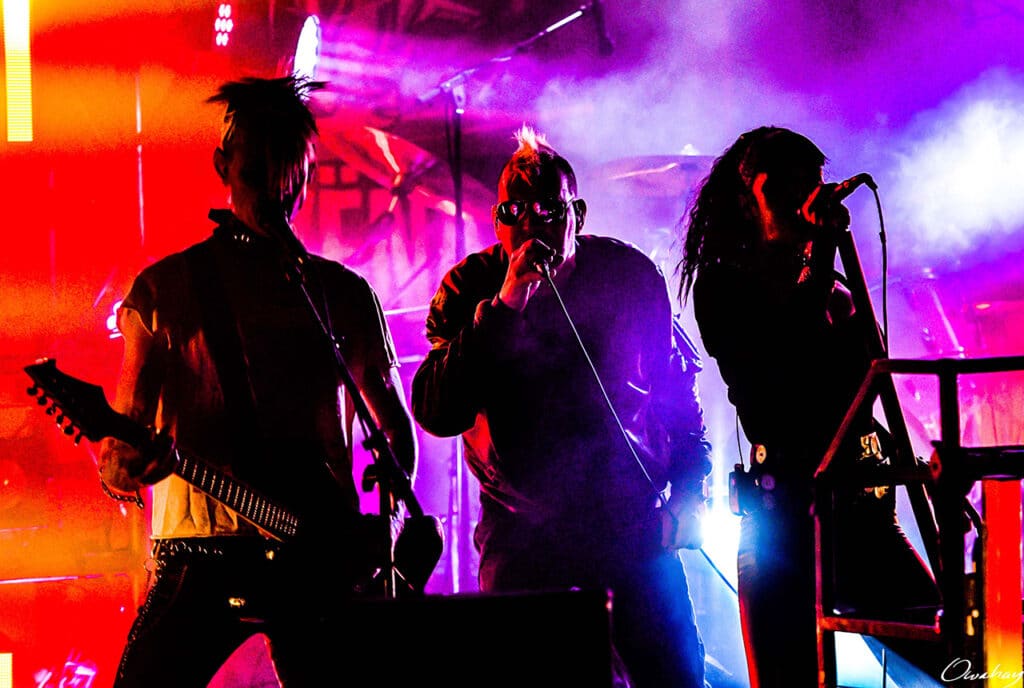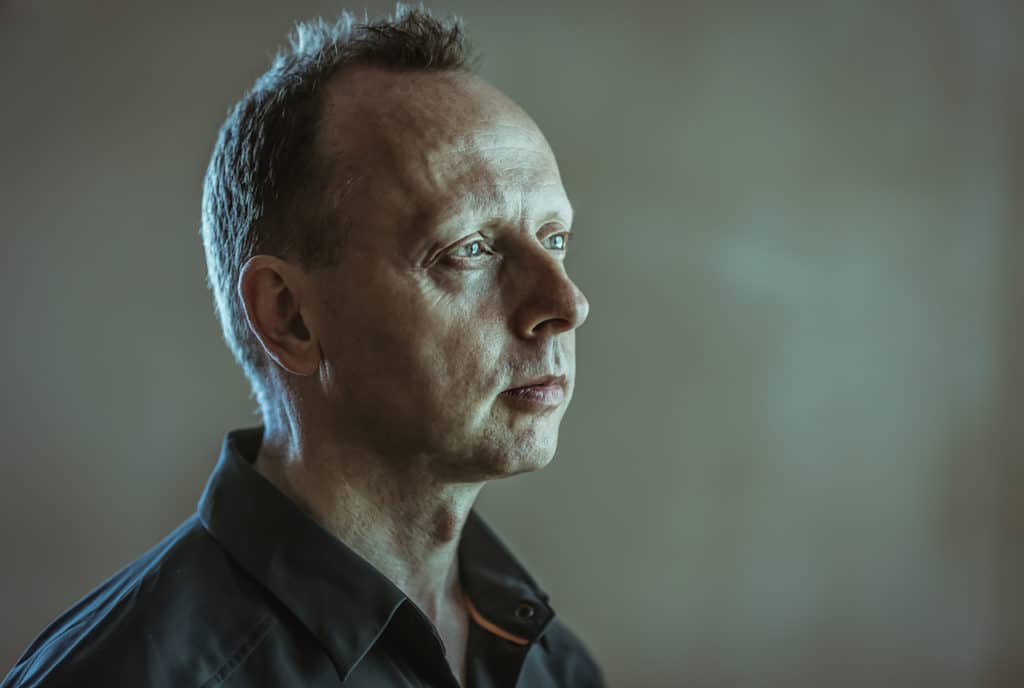Dealing with the international vulnerability from the spread of disease via air travel, Human Impact’s single “Contact” seemed very timely with the outbreak of COVID-19. It was actually written and recorded shortly before the current pandemic, and after weighing the pros and cons of bringing it out now, the group decided the timing was right. They put a call out to fans around the world to send footage for a “Contact” music video, asking the question, “What does this new reality look like for you?” In addition, Human Impact is donating proceeds from the song to the NYC COVID-19 Emergency Relief Fund.
Human Impact grew out of the desire of singer/guitarist Chris Spencer (Unsane) and keyboardist Jim Coleman (Cop Shoot Cop) to work together. Also including bassist Chris Pravdica (Swans, Xiu Xiu) and drummer Phil Puleo (Cop Shoot Cop, Swans), the group released their self-titled debut album in March 2020. Elements of the members’ past projects are evident in Human Impact’s sound, but it all comes together into a cohesive and original style. It’s dark and abrasive, but also at times melodic. As with Cop Shoot Cop, the electronics blend organically with the more typical rock instrumentation.
In a phone interview, Spencer and Coleman discussed the group. Since this was originally posted, the group has released a new EP, EP01. A video from it, for the track “Recognition,” appears after the interview below.
“Contact” is not included on the album; did it come out of the same sessions, or was it recorded afterward?
Jim: After the album was done and in the can, Chris and I just kept working on new stuff. We had the opportunity to do four additional songs we’ve been working on. We were lucky enough to have recorded and mixed those just prior to this new reality we’re in. “Contact” just seemed so timely, of course. Even though the creation of it predated this, it was so much about this that we were like, “Okay, let’s just get this out as soon as we can.”
It’s a very timely song, but actually predates the spread of COVID-19. Could you discuss the inspiration behind it?
Chris: I had been traveling back and forth to New York, working with the guys from Northern California. I had gotten sick multiple times and had this whole idea of sickness traveling through the airlines and how easy it would be to have some virus hit me and everybody else on the plane, and then we all get off and it just spreads everywhere. So, that was the initial inspiration; I had just gotten sick so many times. I bought a mask prior to COVID-19 to wear on a plane. I mean, I actually lately have been thinking I may have been exposed to this before people actually knew it was really here because I got desperately sick prior to this, at the end of January. Who knows, but it was just about how vulnerable everyone is at the time. I mean, before this hit, I could tell that we were all really vulnerable to the transmission of disease.
You crowdsourced footage for the music video. What was that process like?
Jim: We just put out a call for footage. It seemed like an appropriate gesture at the time to see how we could bridge that gap and try to bring people together and have some connective thread in this. It’s kind of a weird ask, because it’s not like dramatic stuff. The reality that everyone finds themselves in is pretty pedestrian. It’s stillness, it’s quietness. It’s not like things blowing up and shit that makes an “interesting rock video.” But that seemed to be the point of it. It’s this silence in relation to the noise of that song. So, there was a great response to that. We did get some stuff that had dramatic elements to it as well, but people were sending in stuff from around the world, and some people sent me stuff almost daily. It was pretty engaging. It was cool.
It’s always a fun challenge, right? Obviously, we did use some stuff that was sourced from other places, which I felt like we needed to create more of a narrative arc to it. But it was similar to other videos. The first stab was kind of a mess. It was like, “Oh, what’s this going to be,” but you’re starting to see something there. As I started working on it, people kept sending me stuff and everything was just in time. It was like, “Oh yeah, this will fit perfectly here.” Every morning you could wake up and get new material to work with. It was like getting a gift each day.
How has COVID-19 affected the band? Did you have touring plans?
Chris: Yeah, we were supposed to go on tour with a band called YOB on the West Coast at the end of March, which completely obviously closed down. That’s been rescheduled to July, which, at this point, we don’t even know if those are going to happen. We have another tour of the States in September that is still up in the air. It’s booked, it’s done, but we’re still not sure about that. And then we’ve got Europe in November, December. So hopefully, that’ll happen too. You hear all kinds of stuff about how long this is going to take, but I really honestly think nobody knows. Who can tell?
A lot of our topics, or things we address on the record, are coming to light in this situation. And people are home, and they’re looking at the internet. So Jim making this video is very good. In terms of timing with the video, having written “Contact” before this happened and having it done, do you put it out now? There could be a potentially horrible backlash. Or do you wait and put it out much later, and then it seems like you wrote a song about COVID-19? So it was like, “Let’s get on this and do this now.” And whether there’s a backlash or not, let’s include people, and the inclusion helps because we’re all in the same boat. So I think there’s been good and bad. There’s been good in that people are on the internet and looking at stuff we’re doing, and there’s bad in that we can’t tour, and no bands can tour, which is horrible.
How did Human Impact initially come together?
Chris: Me and Jim have been friends since like the late ’80s, I think. I have always wanted to work with Jim. Actually, in like ’97, at one point, when Cop Shoot Cop broke up, I had asked the guys in Unsane if Jim could join and do electronics with Unsane. But the guys wanted to stay a three-piece. We were doing a lot of touring all the time, so it would’ve been very difficult. But then Jim came up to me at an Unsane show a few years ago and asked if I wanted to make some music with him. So I was totally in, of course, and we took it from there. Jim and I started writing some stuff; we had no idea where it was going. We just threw ideas out there. Chris Pravdica and Phil, who I’ve known also for a very long time, joined in. And that was really the beginning.
As you said you had no idea where it was going, how do you feel it evolved from the first collaborations to what we hear on the album?
Jim: The first session we did was at Martin Bisi’s. We went in with some rough ideas, and some of them were more thought-out than others. But there was a lot of backend work on that. We came out of that session, and both Chris and I went back to our studios and started dissecting things and really constructing things out of the parts that we had recorded. And there was some strong stuff. There are some strong songs, like “Protester” and “Consequences,” that came out of that session. Coming out of that, I think we both had a better sense of what this was and what it could be.
By the time we went into the second session, which was at Hoboken Recorders with Alan Camlet, we were writing more specifically to our known strengths and potentials. I remember going into rehearse for those record sessions. All of a sudden, it was like, “Oh my God, it’s like the electricity just got turned on.” It was like, “Okay, this is what this is,” and it was really like a light bulb went off; it all started making sense. It was all cohesive, and we were able to write more to our individual strengths, with the four of us, and that’s continued to grow with the four songs we did after the album was complete. It’s still growing exponentially, and expanding exponentially, I feel.
So those additional songs will be getting released?
Jim: Yeah, especially in this situation, it’s nice to have a few extra songs available. I can’t remember when Ipecac is putting one out next. But they’ll be used to bridge the gap when we’re approaching touring, and all that. I mean, those will be digital releases eventually. I would imagine they’ll end up on a physical release as well. And then, in the meantime, we continue working on new material.
How extensively were you able to perform live?
Jim: To date, we’ve done two shows. Yep. That’s all we’ve been able to do. We’re itching to tour, looking forward to it. But we’ve done two shows to date,
How would you compare your live sound to the album?
Chris: Well, I would say there is definitely a higher energy, live energy, feeling to everything. We’ve actually rehearsed for these shows and really worked it out in terms of playing live. But we don’t change the songs; there’s more to it. With the last show, the record release, which we refer to as the Pandemic Show, Jim and I did electronic stuff because both the opening bands canceled. We had a slot there to fill for a while. Jim and I were doing electronic stuff and then the band started and there were more in-between songs, atmosphere stuff going on, which was really cool. So it is a little different in that there’s a lot more to it than just the album. But at the same time, the songs are played the same way they are on the record. We’re not changing the actual songs at all.
Jim – musical technology has evolved quite a bit since you were using electronics with Cop Shoot Cop. How has that affected how you create and perform music?
Jim: Yeah, it’s interesting. In fact, in the days of Cop, you couldn’t lug a computer around and put it on stage. I mean, you could, but it was all desktops and stuff like that, and computers had such limited capabilities. I remember even after Cop, the first Fila Records I was doing, it was all computer. I worked on the computer, but it was all midi sequencing in Opcode Studio Vision. So it was very different; it was all hardware-based. When we started with Cop, I was using these Ensoniq Mirage samplers that ran off a floppy disk. Each floppy disk held something like less than two megabytes of material on it. So you’d have to change them for each song, and that was a long process.
The funny thing is, now it’s like, “Okay, there’s tons more, you can just do so much more, and we’re doing so much more. I still have to change each program between songs, and you’ve got to wait for it to load and all that, but it’s what we’re using, and in terms of sonically, it is so much above and beyond. So yeah, the technology grows, but so do our expectations about how we use it. For me also, I think in the interim, with Cop, I knew how to use an Akai sampler and a control keyboard, and I knew that completely. Since then, I’ve become addicted to gear in some way. So, it’s like I have a bunch of stuff to play with, and some of it’s really underutilized, but it’s a challenge in terms of bringing down that world of possibilities into something finite and making the right choices.
For more info, visit humanimpactband.com.










